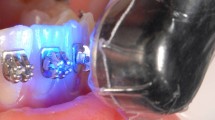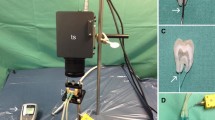Abstract
In dental research, restorative materials have been regularly subjected to alternating in vitro thermal stress in investigations since the 1950s, in order to simulate in vivo alternating temperature stress and to artificially stress them in vitro. The provocation temperature is mostly 5°C for cold provocation, and 55°C for hot provocation. These temperatures are determined quite arbitrarily based on very few examinations in vivo. Extensive temperature data for the approximal space of teeth, which is decisive for the success of fillings adhesively attached to dentin, has so far not been addressed. The objective of this study was to examine the interproximal temperature characteristics created in the space of all teeth in vivo with thermal alternating stress, and therefore to validate the in vitro standardized thermal alternating stress of 5–55°C. Fifteen study participants with healthy teeth were used to determine the temperature in each inter-dental space, resulting from hot/cold provocation in the upper and lower jaw, from the central incisor to the second molars. This was performed by a thermal element (cable sensor GTF 300, Greisinger Electronic GmbH, Regenstauf, Germany). The temperature sensor was attached with dental floss into the interproximal space and the temperature was recorded by the computer. The participants in the pilot test had to state when they were able to sip an 85°C hot drink. That particular temperature value was taken for hot provocation as maximum temperature reference. Cold ice water (0°C) was used for cold provocation as minimum temperature reference. The respective recordings with a total of 14 measurements for each individual were performed simultaneously in the upper and lower jaw. The study participants were to start with hot provocation, followed by cold provocation. This cycle was repeated at least once with an individual dwell time. The highest recorded approximal space temperature was 52.8°C in the lower jaw, between the first and the second premolar. The lowest temperature of 13.7°C was recorded in two participants in the upper jaw, between the 1st and 2nd incisor, and between the two central incisors. The mean of the maximum temperatures was 43.8±3.7°C, and the mean of the minimum temperatures 24.2±4.6°C. The mean initial temperature was 35.2±1.3°C. None of the recordings reached either the upper threshold (55°C) or the lower threshold (5°C). This study showed that the actual thermal stress in the interproximal space of teeth is slightly lower than the one used in in vitro examinations. For class II cavities, most of the alternating temperature stress limits selected at 5–55°C cover the actually occurring temperature interval quite well.



Similar content being viewed by others
References
Arnold M, Cendelin E (1984) Marginale und papilläre Sulcustemperatur. Stomatologie der DDR 34:460–464
Arnold M, Richter K (1979) Objektivierung klinischer Befunde an der Gingiva (Objectifying of clinical diagnostic findings at the gingiva). Stomatologie der DDR 29:141–145
Bachmann A, Lutz F (1976) Schmelzsprünge durch die Sensibilitätsprüfung mit CO2-Schnee und Dichlor-difluormethan- eine vergleichende In-vivo-Untersuchung (Enamel cracks caused by sensitivity tests with dry ice and Dichlorodiflouromethane: a comparative in vivo study). Schweiz Mschr Zahnmed 86:1042–1059
Barker R, Rafoth R, Ward RW (1972) Thermally induced stresses and rapid temperature changes in teeth. J Biomed Mater Res 6:305–325
Bergström J, Varga G (1971) Temperatures of the oral cavity in 50 healthy students. Swed Dent J 64:157–164
Boehm PF (1972) Thermal environment of teeth during open-mouth respiration. J Dent Res 51:75–78
Brown AS, Goldberg MP (1966) Surface temperature and temperature gradients of human teeth in situ. Arch Oral Biol 11:973–982
Brown WS, Jacobs HR, Thompson RE (1972) Thermal fatigue in teeth. J Dent Res 51:461–467
Eakle WS (1986) Effects of thermal cycling on fracture strength and microleakage in teeth restored with bonded composite resin. Dent Mater 2:114–117
Finger W (1974) Die Wärmeausdehnung von Composite-Füllungsmaterialien und ihre klinische Bedeutung (Thermal expansion of composite restoration materials and its clinical significance). Schweiz Mschr Zahnmed 84:630–647
Fouke J, Wolin A, Bowman F, McFadden R (1990) Effect of facial cooling on mucosal blood flow in the mouth in humans. Clin Sci 79:307–313
Franke J (1951) Über Temperaturmessung in der Zahnumgebung und ihre Bedeutung für die Kenntnis der Durchblutungsverhältnisse des gesunden und erkrankten Parodontiums (Temperature measurement and its significance for acquiring blood circulation rates of healthy and inflamed parodontium in dental environment). Dtsch Zahnärtzl Z 6:1368–1375
Gente M, Sondermann U, Lehmann KM (1985) Linearer thermischer Ausdehnungskoeffizient von Rinderschmelz und Rinderdentin (Linear thermal expansion coefficient of bovine enamel and dentin). Dtsch Zahnärztl Z 40:488–490
Gente M, Sondermann U, Lehmann KM (1986) Untersuchung zur Krümmung von Schmelz-Dentin-Streifen bei Temperaturveränderung (Study of the deflection of enamel-dentin-lines during temperature changes). Dtsch Zahnärztl Z 41:847–852
Gräf W (1960) Die thermische Belastung der Zähne beim Verzehr extrem heißer und kalter Speisen (Thermal exposure of teeth during the consumption of extremly hot and cold food). Dtsch Zahnärztl Z 15:30–34
Hamlet S, Choi J, Zormeier M, Shamsa F, Stachler R, Muz J, Jones L (1996) Normal adult swallowing of liquid and viscous material: scintigraphic data on bolus transit and oropharyngeal residues. Dysphagia 11:41–47
Hellwig E, Klimek J, Attin T (1995) Einführung in die Zahnerhaltung (Introducing operative dentistry). Urban und Schwarzenberg
Hensel H, Mann G (1956) Temperaturschmerz und Wärmeleitung im menschlichen Zahn (Thermal pain and thermal conduction in human teeth). Stoma 9:76–85
Herrmann M (1953) Temperaturverhältnisse an der Mundschleimhaut und den Zähnen (Thermal proportions of oral mucosa and teeth). Dtsch Zahnärztl Z 8:539–543
Holthuis AF, Gelskey SC, Chebib FS (1981) The relationship between gingival tissue temperatures and various indicators of gingival inflammation. J Periodontol 51:187–189
Jacobs HR, Thompson RE, Brown WS (1973) Heat transfer in teeth. J Dent Res 52:248–252
Kidd E (1976) Microleakage: a review. J Dent 4:199–206
Kidd E (1976) Microleakage in relation to amalgam and composite restoration: a laboratory study: Brit Dent J 16:305–310
Klengel S, Arnold M (1992) Abhängigkeit der Gingivatemperatur vom zirkadianen Rhythmus (Temperature-dependence of the gingiva on the circadian rhythm). Zahnärztliche Praxis 9:340–343
Lloyd BA, McGinley MB, Brown WS (1978) Thermal stress in teeth. J Dent Res 57:571–582
Longman C, Pearson G (1987) Variations in tooth surface temperature in the oral cavity during fluid intake. Biomaterials 8:411–414
Mesu FP (1983) The effect of temperature on the compressive and tensile strengths of cements. J Prosthet Dent 49:59–62
Michailesco PM, Marciano J, Grieve AR, Abadie MJM (1995) An in vivo recording of variations in oral temperature during meals: a pilot study. J Prosthet Dent 73:214–218
Mukherjee S (1978) The temperature of the gingival sulci. J Periodontol 49:580–584
Nell A, Loicht Ch, Emmer W, Sperr W (1994) Ergebnisse von Temperaturmessungen im Sulcus gingivae (Results of temperature measurements in the gingival sulcus). Zeitschrift für Stomatologie 91:9–17
Nelsen JN, Wolcott RB, Paffenbarger GC (1952) Fluid exchange at the margins of dental restorations. J Am Dent Assoc 44:288–295
∅ilo G (1993) Bond strength testing—what does it mean? Inter Dent J 43:492–498
∅ilo G, Austrheim EK (1993) In vitro quality testing of dentin adhesives. ACTA Odontol Scand 51:263–269
Palmer DS, Barco MT, Billy EJ (1992) Temperature extremes produced orally by hot and cold liquids. J Prosthet Dent 67:325–327
Peterson EA, Phillips RW, Swartz ML (1966) A comparison of the physical properties of four restorative resins. J Am Dent Assoc 73:1324–1336
Pfeifer M, Marx R (1989) Temperaturbelastung von Adhäsivbrücken und Ihre Auswirkung auf die Verbundfestigkeit der Klebeverbindung (Thermal exposure of adhesive bridges and its effects on the bonding strength). Schweiz Mschr Zahnmed 99:782–786
Plant C, Jones D, Darvell B (1974) The heat evolved and temperatures attained during setting of restorative materials. Brit Dent J 17:233–238
Retief DH, Woods E, Jamison HC (1982) Effect of cavosurface treatment on marginal leakage in class V composite resin restorations. J Prosthet Dent 47:496–501
Roydhouse RH, Paxon PR (1970) Thermal changes in dimension of restorative cavities. J Dent Res 49:567–571
Schmidt RF, Thews G (1990) Physiologie des Menschen (Human physiology). 24. Auflage, Springer, Berlin Heidelberg New York
Seltzer S (1955) The penetration of microorganisms between the tooth and direct resin fillings. J Am Dent Assoc 51:560–566
Simmons EW, Barghi N, Muscott JR (1976) Thermocycling of pit and fissure sealants. J Dent Res 55:606–610
Spierings T, Peters M, Bosman F, Plasschaert A (1986) The influence of cavity geometry on heat transmission in restored teeth. J Dent 14:47–51
Spierings T, Peters M, Bosman F, Plasschaert A (1987) Verification of Theoretical Modeling of Heat Transmission in Teeth by in vivo Experiments. J Dent Res 66:1336–1339
Stettmaier K, Kinder J, Vahl J, Reinhardt KJ (1978) Untersuchungen des thermischen Verhaltens von Schmelz, Dentin und ausgewählten Dentalwerkstoffen (Evaluation of the thermal reaction of enamel, dentin and selected dental materials). Dtsch Zahnärztl Z 33:474–476
Tanaka T, Kamada K, Matsumura H, Atsuta M (1995) A comparison of water temperatures for thermocycling of metal-bonded resin specimens. J Prosthet Dent 74:345–349
Thews G, Vaupel P (1981) Wärmehaushalt. Grundriß der vegetativen Physiologie (Heat balance. Compendium of vegetative physiology). Springer, Berlin Heidelberg New York, pp 237–253
Tibbetts V, Schnell M, Swartz M, Phillips RW (1976) Thermal diffusion through amalgam and cement base: comparison of in vitro and in vivo measurements. J Dent Res 55:441–451
Volchansy A, Cleaton-Jones P (1994) Variation in oral temperature. J Oral Rehabil 21:605–611
Youngson C, Barclay C (2000) A pilot study of intraoral temperature changes. Clin Oral Invest 4:183–189
Author information
Authors and Affiliations
Corresponding author
Rights and permissions
About this article
Cite this article
Ernst, CP., Canbek, K., Euler, T. et al. In vivo validation of the historical in vitro thermocycling temperature range for dental materials testing. Clin Oral Invest 8, 130–138 (2004). https://doi.org/10.1007/s00784-004-0267-2
Received:
Accepted:
Published:
Issue Date:
DOI: https://doi.org/10.1007/s00784-004-0267-2




